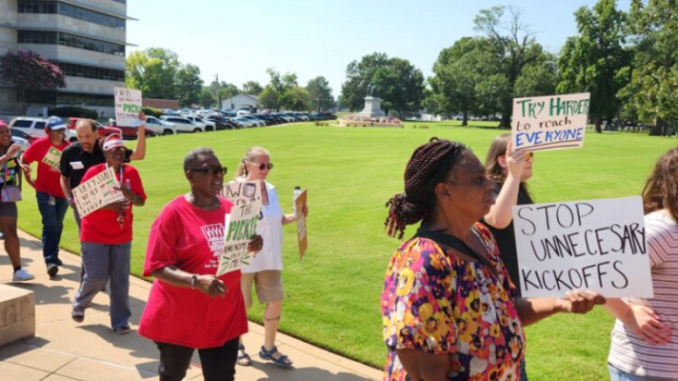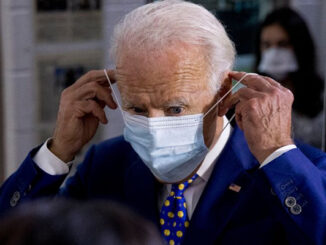
Since pandemic protections expired, nearly 4 million people have lost coverage over paperwork.
Despite federal warnings to slow down, both red and blue states have cut off Medicaid coverage for nearly 4 million people because they lack the proper paperwork. In at least four states, half of all the people who have lost coverage for any reason are children.
During the pandemic, the federal government directed states not to remove anyone from Medicaid, the joint federal-state health care program for low-income people and people with disabilities. But states were cleared to resume eligibility and paperwork checks starting April 1.
As of Wednesday, nearly three-quarters of the roughly 5.4 million Medicaid recipients who’ve lost coverage were terminated because of “procedural” reasons, according to an analysis from KFF, a health care policy research organization. (Results were based on the responses from 39 states and the District of Columbia.)
Those removals happened due to an incomplete renewal process, whether because of missing paperwork, outdated contact information or a renewal form not sent by a specified date.
This month, the Centers for Medicare & Medicaid Services (CMS) mailed letters to every state, saying long wait times and high procedural termination rates might violate federal regulations to keep those who are eligible enrolled.
The letters came weeks after federal officials raised concerns about overzealous efforts to purge the rolls and gave states extra flexibility to re-enroll patients. Some states, such as Maine, paused removals.
The process has proven confusing for many patients, such as those whose first language isn’t English or those who don’t have computers.
Experts and advocates say grassroots efforts are needed to reach former recipients and help people re-enroll, stressing that lack of coverage threatens the health of vulnerable communities, including people of color, who make up a disproportionate number of Medicaid enrollees, as well as rural residents and children.
Public health professionals know poverty often leads to poor health, and the pandemic impeded critical and preventive care.
“Care got delayed, screenings got put off, therapies got interrupted,” said emergency medicine physician Dr. Georges Benjamin, executive director of the American Public Health Association, an advocacy group that represents public health professionals. Now, “they don’t have a mechanism to pay for their care. Their care is delayed even further.”
‘Across the board’
Texas has terminated coverage for more than half a million people, more than any other state, out of about 5.9 million Medicaid recipients, and 80% of them were removed for procedural reasons, according to the KFF analysis. About 408,000 Floridians have lost coverage out of about 5 million, more than half for procedural reasons.
Texas and Florida are Republican-dominated states that have declined to expand Medicaid under the Affordable Care Act, also known as Obamacare. But Democratic strongholds that have opted for expansion also have removed tens of thousands of people for procedural reasons. New Mexico (97%), Washington (90%), Connecticut (87%), Minnesota (85%), California (85%), Rhode Island (73%), Colorado (67%), Vermont (66%), Maryland (65%) and New York (53%) are among the 34 states plus the District of Columbia (90%) where more than half of people were removed for failing to file the proper paperwork.
California, New York and Washington state are among the states that have terminated the most people since April. In California, 255,000 people were removed from the rolls for procedural reasons. In New York, about 179,000 removals were procedural, and in Washington state, 247,500 removals were for administrative reasons.
Cadence Acquaviva, spokesperson for the New York State Department of Health, argued the KFF reports are a “snapshot in time” and don’t reflect those who transitioned to other lower-cost state health plans established under the Affordable Care Act.
“It remains the Department’s goal to maintain affordable, high quality health coverage for New Yorkers who qualify throughout the ongoing redetermination process,” Acquaviva wrote in an email to Stateline. She said as of July 31, more than 83,000 of the more than 300,000 people removed were found eligible for and enrolled in other health plans.
California state health officials assert they are following federal regulations. Residents who lost coverage through Medi-Cal (the state’s Medicaid program) due to procedural reasons have 90 days to send missing information to the Medi-Cal office, a California Department of Health Care Services spokesperson said.
The department is “conducting outreach to Medi-Cal members, including vulnerable members, recently discontinued to assist them in completing their renewal” during the 90-day period, spokesperson Anthony Cava said.
When Stateline asked about New Mexico’s high procedural removals rate, the state Human Services Department asserted it prioritized people “assessed as likely ineligible” during the first four months of unwinding, leading to a “higher number of procedural denials during these months,” spokesperson Timothy Fowler said in an email.
The agency also said it’s working with managed care organizations and BeWellNM, the state health insurance exchange, to connect procedurally removed patients with lower-cost insurance options.
A spokesperson for Republican Gov. Sarah Huckabee Sanders of Arkansas — a GOP-dominated expansion state, where 77% of about 300,000 removals were procedural — told local media this week that the state has been abiding by state and federal law.
“[The Department of Human Services] is using every tool to ensure people who are eligible remain covered and working with those who are no longer eligible to get coverage through their job or the healthcare marketplace,” spokesperson Alexa Henning told the Arkansas Advocate.
In a handful of states, most people were removed from the Medicaid rolls because they were no longer eligible, not for technical reasons. In Michigan, for example, only 17% of more than 23,000 removals were procedural. The state’s Department of Health and Human Services said in a statement it has also simultaneously renewed enrollment for 121,000 recipients, and that it is reinstating people who remain eligible for the program but were removed for procedural reasons.
In Texas, where Latino households rank lowest in median household income, the state health department says it’s working with community organizations to conduct outreach efforts.
“This includes sending notices, text messages and robocalls, hosting community renewal assistance events throughout the state as well as leveraging community partners to assist with outreach efforts. We’re collaborating with health care providers, community organizations, and advocacy groups to reach a wide range of individuals who may be affected by the changes,” a spokesperson told Stateline in an emailed statement.
Sonia Lara, director of outreach and enrollment at the Texas Association of Community Health Centers, said her agency worked on Spanish radio ads to reach families and is getting the word out to patients to make a free appointment for help with health centers’ staff.
“We aren’t done with the messages,” she said. “We’ve been doing this for a long time. Outreach is part of our fiber.”
A report by UnidosUS, a Latino civil rights organization, found stark disparities in average wait times to Florida’s Medicaid call center: The average English-speaking caller had to wait 36 minutes before being connected with a representative, compared with Spanish-speaking callers, who had to wait 2 1/2 hours on average. Similarly, nearly a third of Spanish-language calls were disconnected before the caller reached a representative, compared with just 10% of English calls.
The issue is problematic for households where adults and caregivers work multiple jobs, don’t have the flexibility to wait on the call, or don’t have computers to file applications online, said Andrea Vendetti, a senior program manager at the Clearwater, Florida-based nonprofit Hispanic Outreach Center. Many of her clients missed renewal windows and must reapply from the beginning, delaying care even further, she said.
In California, where about half of Medicaid recipients are Hispanic and roughly 30% are Spanish speakers, 53% of those removed from the rolls are Hispanic, according to data from the state’s Department of Health Care Services. Earlier this month, two health care advocacy groups called on the state to ratchet up its outreach efforts.
“Language accessible information and culturally responsive trusted messengers must be prioritized to keep these populations enrolled in life-saving health programs,” said Dr. Seciah Aquino, executive director of the Latino Coalition for a Healthy California.
Children and rural residents
Of the 15 states that reported total removals by age group, Texas reported the highest percentage of children removed, at 81%, followed by Idaho, Kansas and Missouri, where at least half of those removed were children, according to KFF.
In Kansas, about 52% of Hispanic or Latino children live below 200% of the poverty level, compared with 27% of white children, according to the Annie E. Casey Foundation Kids Count Data Center. Pediatrician Dr. Gretchen Homan sees families in the Wichita area and said many of her patients need more support.
The clinic has a full-time translator and a social worker who is helping families navigate renewals. Nearly 80% of Homan’s patients are on Medicaid, and many speak English as a second language or have complex health conditions such as cerebral palsy or autism.
One mother, whose children have chronic illnesses, told Homan she’d been awaiting renewal packets, only to find that the mailbox she shares with a neighbor was too full. Mail wasn’t being delivered and instead was sent back.
“She said, ‘This is really hard, and my kids have been without their medicine for the last month,’” Homan recalled.
Because Kansas has not expanded Medicaid eligibility, “fewer members are able to be renewed through the passive process,” said Matthew Lara, communications and legislative affairs director of the Kansas Department of Health and Environment. Kansas is one of the 11 states for which KFF did not have a breakdown of how many removals were procedural.
“Expanding Medicaid would increase passive renewal rates, decrease the number of members who would be at risk for procedural termination, and decrease call volumes,” he wrote to Stateline in an email.
He also said the letter from CMS is based on data from May, and the Kansas department has since made adjustments to address concerns, such as adding a chatbot to the KanCare website, hiring more call center staff and allowing renewals when no income data is returned.
Community Care Network of Kansas, a coalition of community health centers that includes low-income and rural health clinics, provides outreach training to clinics’ staff. The agency released social media renewal toolkits in English and Spanish for health centers to post on their social media pages and share.
“It’s an injustice if somebody is denied just because of paperwork, just because of administrative things,” said Scott Anglemyer, the network’s policy director. “That’s not right, and that’s not the purpose of government. The purpose of government is to help citizens thrive, and if we’re kicking people off just because of administrative reasons, we’re not helping them.”
.
Nada Hassanein is a health care reporter for Stateline with a focus on inequities.
.



